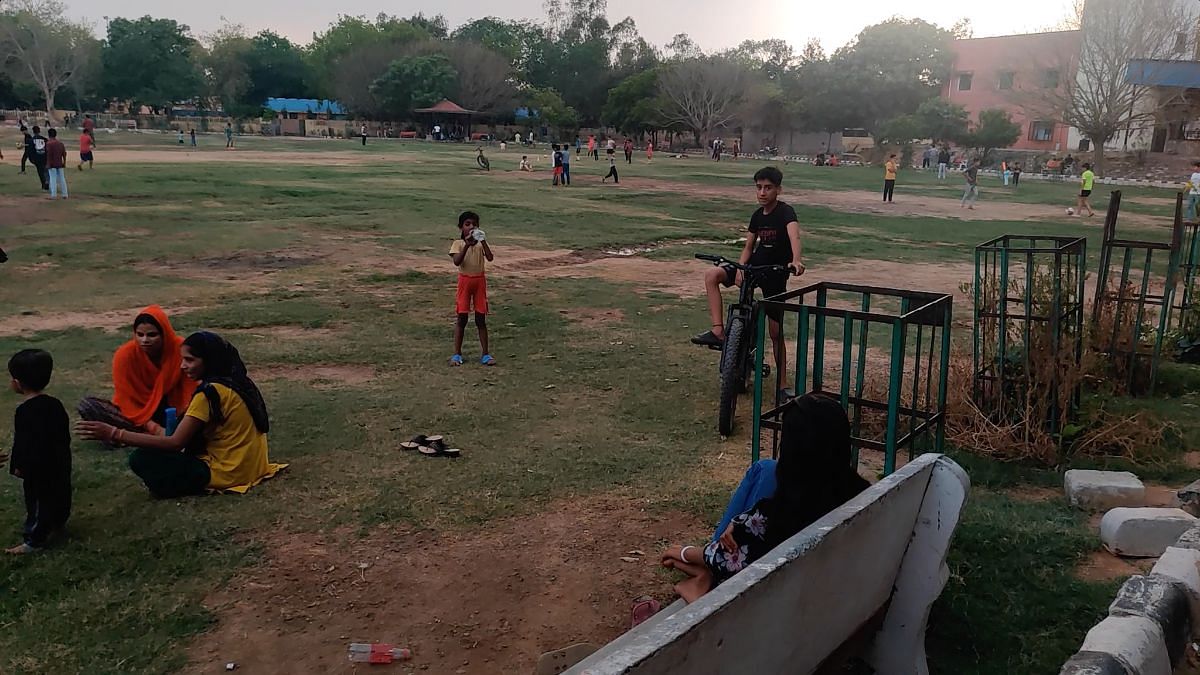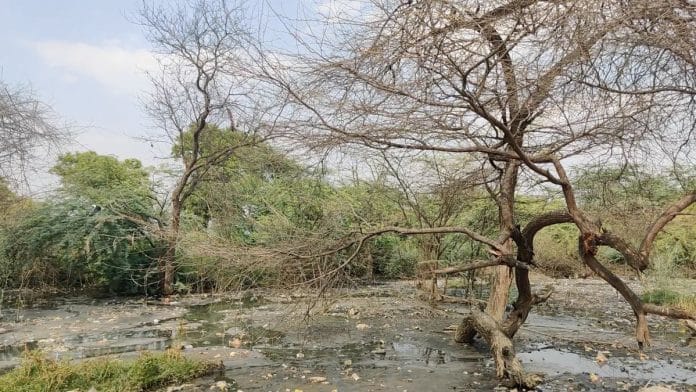New Delhi: On the outskirts of southwest Delhi lies Kanganheri village, away from the hustle and bustle of the national capital.
A pond, right in the middle of the village, was the main attraction here until a few years ago. Tall trees lined it, and every winter season, migratory birds would also make a visit. But two years ago, a portion of this water body was filled up with concrete, sand and cement using earth levellers.
Today, it is difficult to tell that a pond ever existed at this site. All that stands is a large community centre awaiting inauguration. Just a few metres away, traces of the pond can be seen, now reduced to the status of a drain. It’s the residents’ dump yard.
“In our last meeting with the MLA, we were told that they will be building a park over the remaining portion of the pond,” said Manish Kumar, a resident of the village.
According to the Delhi Wetland Authority — a state body created to protect the natural water bodies in the city — the national capital has 1,045 waterbodies. But many of these exist only on paper. Some have become victims to garbage dumping and poor maintenance, others have been encroached, in most cases by government agencies. And residents are trading water bodies for parks and community centres without any ecological consideration. This is also an easy route for authorities who keep passing on the buck for their revival and maintenance. With multiple agencies owning these wetlands, there is confusion on who moves and when.
According to the Delhi Wetland Authority — a state body created to protect the natural water bodies in
the city — the national capital has 1,045 waterbodies. But many of these exist only on paper. Some have become victims to garbage dumping and poor maintenance, others have been encroached, in most cases by government agencies.
Also read: How Punjab farmers sacrificed high income for a big cause—they gave up Pusa-44 this year
Water bodies only on paper
The residents of Shahbad Mohammadpur, a village near the Indira Gandhi International Airport, remember the two local johads (ponds).
Women would wash clothes in one corner of the pond. In summers, children would dive into its shallow waters. One of the two ponds even had fish, according to residents.
Today, a playground is located on one site. The other has been concretised and abandoned. What remains of these once brimming ponds are just old boards, which recognise the site as “Delhi Development Authority Waterbody.”
“The government agencies had a few rounds of discussions with the residents. Some of whom were completely against the closing up of the ponds citing ecological reasons, but there was a sizeable population in the village that was in favour of converting the ponds into community spaces,” said Vijender Singh, a 45-year-old resident.
Singh has lived in the village all his life. It irks him that his children never got to witness the ponds around which he spent his childhood.

Experts said that residents are lured into choosing development over their local waterbodies because these were never properly maintained by agencies. Instead of living around a garbage-strewn, stinky, disease-bed, residents trade it for better facilities.
Paras Tyagi, co-founder of the Centre for Youth, Culture, Law and Environment (CYCLE), said villagers live with such basic amenities that a road or a community centre often sounds like a better deal than having an under-maintained pond in the vicinity. Such a trade-off would be dangerous for the city’s ecology.
“Cities such as Bengaluru and Chennai are facing the brunt of building over its waterbodies. Why can’t we learn from their mistakes? In government documents, this construction is referred to as ‘legal encroachment’. What does that mean?” Tyagi said.
A study conducted by Tyagi’s organisation in 2020 analysed 1,009 waterbodies in Delhi and found that 302 were partially or fully encroached. Another 100 were shrinking because of garbage and sewage deposits, and 345 had completely dried up.
The neglect is not new and is evident in the experiences of older residents.
Kiran Devi, 80, living in Shahbad Mohammadpur, said there was nothing romantic about the water bodies in the village. Trash would never get cleared, and the stagnant water had become a breeding ground for mosquitoes.
But these ponds were not always in such a dismal state. When she came here after getting married, over 60 years ago, these waterbodies brimmed with clear water.
“At least we can sit in the park and walk around. What would we do with such a dirty pond? Die in it?” she said.
In Paprawat, another village near Najafgarh, the local pond has been converted into a sports centre. But the digging didn’t stop. The place was dug up again to make a swimming pool for the youth of the area.
Government apathy over the years has been so blatant that the courts had to step in.
In April this year, the Delhi High Court directed the state government to ensure that all wetlands are apprised for maintenance by the end of 2024.
Coming down heavily on the state, the court said, “several waterbodies out of 1045 listed do not exist on the ground as on date”. The latest court order has asked the government to geo-tag all water bodies by 15 May and finish rejuvenation by 31 December.

Also read: Mathura culture, Mahabharata Period — ASI digs Govardhan Hill after 50 years
No protection of wetlands in Delhi
Taking note of the degradation of water bodies in states, a specific category of water bodies called ‘wetlands’ was recognised in 2017 by the governments to ensure its protection. Wetlands are land parcels either temporarily or permanently covered by water, which help enable groundwater recharge and support biodiversity because of their unique landscape.
After the Wetland Conservation and Management Rules 2017 were passed 2017 by the central government, all state governments were required to constitute a State Wetland Authority.
Even after five years of existence, the Delhi Wetland Authority has not notified a single wetland in Delhi, despite there being over 490 wetlands listed on the Wetlands of India portal
According to the rules, each state wetland authority needed representation from departments including environment, urban development, water, fisheries and the state pollution control board. This was done to ensure the protection and rejuvenation of wetlands holistically.
These wetland authorities are tasked with developing a list of all wetlands in the state, recommending wetlands for notification, and devising strategies to help conserve wetlands within their jurisdiction.
In Delhi, the task of conservation stopped at the formation of the authority.
The Delhi Wetland Authority, conceived in 2019 as per the Wetland Conservation Rules, has met only five times between 2019 to 2021. There is no record of a meeting, or a ruling passed by the authority since.
What is even more alarming is that even after five years of existence, the Delhi Wetland Authority has not notified a single wetland in Delhi, despite there being over 490 wetlands listed on the Wetlands of India portal.
Also read: Masala, morality, real estate—Bengaluru dosa walk turns into overload of history & heritage
Passing the buck
While wetlands have been marked for conservation and rejuvenation, these are yet to be notified. The notification will officially recognise these water pockets and provide them legal protection from ecological degradation and encroachment.
Experts said that the process of notification has not progressed because of multiple ownerships of these water bodies. The more the agencies owning claim over these waterbodies, the more difficult it becomes to fix accountability and easy for authorities to pass the blame.
“There are 1,045 water bodies in Delhi, and 16 different agencies among which the ownership of these water bodies is shared,” said Rajesh Roshan, member of the Delhi Parks and Gardens Society, which is a wing of the Government of National Capital Territory Delhi responsible for managing the green cover. The Wetland Authority of Delhi too comes under this Society.
The notification of the wetlands will require permissions from each of these agencies, he said.
Some of the landowning agencies include the Delhi Development Authority, Delhi Jal Board, the forest department, and the Archaeological Survey of India (ASI).
DDA is the largest landowning body in the city. The Delhi Wetland Authority website shows that 822 of the total water bodies in Delhi are owned by the DDA, including the Tikri Khurd lake in northwest Delhi that has been due for restoration for years.
The other main water bodies identified by the Delhi Wetland Authority for protection — Bhalswa Lake, Smriti Van and Sanjay Van — are also under the ownership of DDA and have earlier been the subject of controversy due to delay in their notification.

Also read: AMU VC Naima Khatoon is facing questions from ‘bearded elite’—Smashing glass ceilings daily
Wetland Authority, a paper tiger
An analysis of the minutes of the five meetings of the Delhi Wetland Authority reveals the myriad bureaucratic delays in protecting even one wetland.
From the first meeting in 2019, the DWA requested all members and land-owning agencies to prepare a list of the wetlands in Delhi with accurate details. It took the better part of two years and three DWA meetings between 2019 and 2021, for the authority to get these details. Even then, the 4th DWA meeting in January 2021 mentioned how these details were not correctly formatted by some agencies like the DDA, despite the availability of “hand-holding workshops” and YouTube videos describing the process of formatting.
“There was a time (nearly three decades ago) when this waterbody was extended up to our doorsteps. The water was so clean that we could drink it directly,” said Santosh, filing her bucket. Back then the village never faced any water difficulty.
“The younger generation doesn’t remember. They prefer a park or a community centre over a pond. We are witnessing how that is turning out,” Santosh smiles.
(Edited by Anurag Chaubey)






